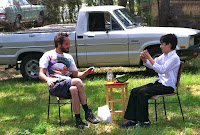 |
| 1 Tuber, Brandon. "Design Board". Photo. June. 2012. |
Create a final design based on one Principle and two Elements of Design related to my future career in Interior Design.
I designed a 12'x10' modern shed living space. (1) This is done while keeping in mind the issued principle of design , Proportion, as well as the two issued elements, Color and Illusion of Space. I have used interior proportions to create a livable space in a 12x10 shed. Scale plays its roll once the client is introduced. Color was established by creating an all around pallet and splashing color in to create emphasis by contrast. The illusion of space is seen from the drawing of the exterior without a reference. Upon completion of this project photos would be taken to back up this claim. Now to find investors.
Chapter 1: Planning
 |
| 2 Tuber, Brandon. Photo. June. 2012 |
 |
| 3 Tuber, Brandon. Photo. June. 2012 |
This project was allotted 3 days. This included a trip to the local Target, Hobby Lobby (2) and Home Depot (3) as well as endless hours in front of the computer capturing images for the living space.
I used all three spots for inspiration, as well as a resource for supplies. Fabric, One original sketch made the final cut. You can see its creation on my drafting board. (4) Foam board, fabric, and paper samples were purchased at Hobby Lobby. (5)(6)(7) Photo paper at Target. Home Depot (8) rounded out the trip with flooring and paint samples.
 |
| 4 Tuber, Brandon. "Home Office". Photo. June. 2012. |
 |
| 8 Tuber, Brandon. Photo. 2012 |
 |
| 5 Tuber, Brandon. Photo. 2012 |
 |
| 7 Tuber, Brandon. Photo. 2012 |
 |
| 6 Tuber, Brandon. Photo. 2012 |
Chapter 2: Revisions
The revisions that took place comprised of breaking down the massive amounts of images, (8) printing the chosen images (9) and the final arrangement of the board. (10) Once all these were completed the board was glued using good old Elmers Glue and a generic glue stick.
 |
| 8 Tuber, Brandon. "My Computer". Photo. 2012 |
 |
| 10 Tuber, Brandon. Photo. 2012 |
 |
| 9 Tuber, Brandon. Photo. 2012 |
Chapter 3: Presentation
See i.design blog post Final Project/Final Post at:
http://www.blogger.com/blogger.g?blogID=5019699105095471857#editor/target=post;postID=318523140618696184
Also, see this board in person at:
Dr. Honoria Starbuck's Monday 8 am class at the Art Institute of Austin.
Chapter 4: Assessment
100% - I have created a project that utilized my issued principle and two issued elements. I have documented my field trips and my creative process on my completed Text Book Blog Project.









































